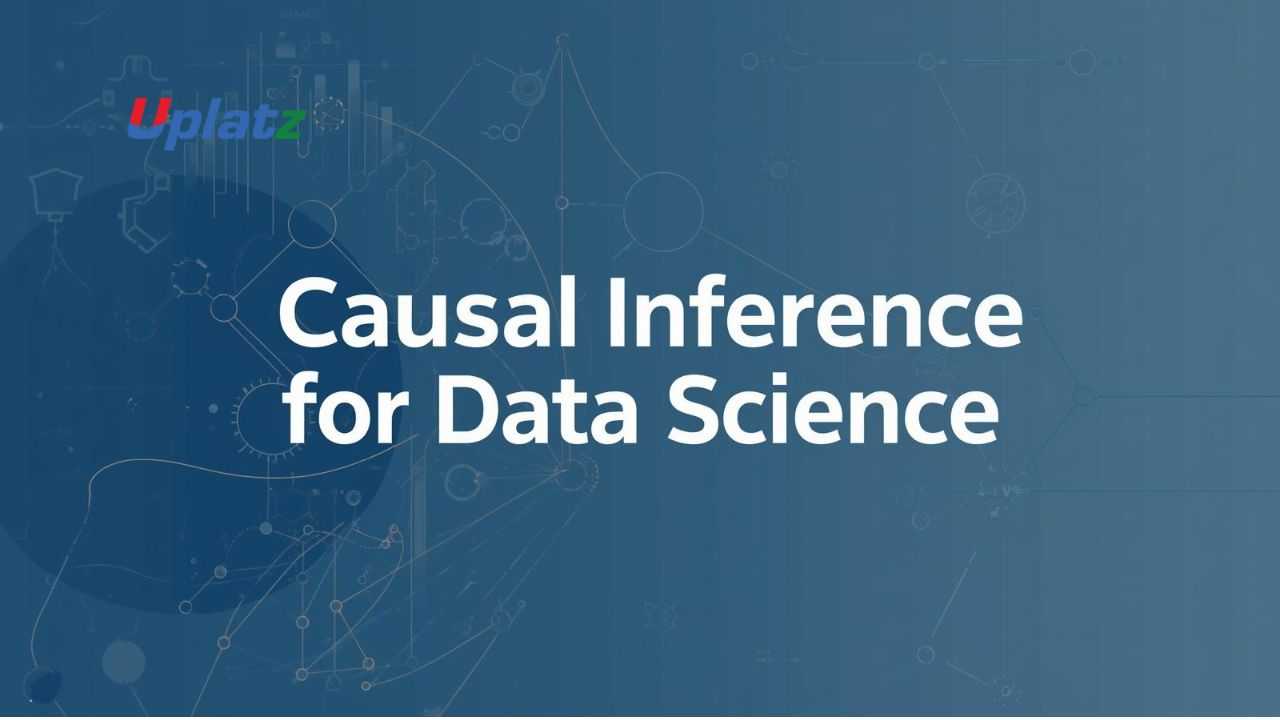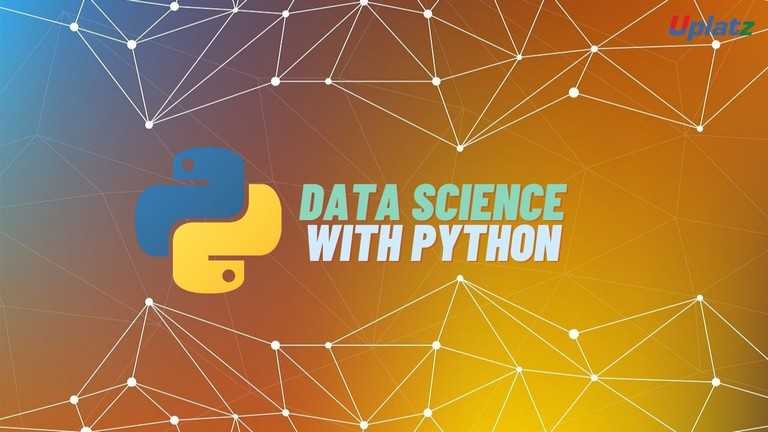Causal Inference for Data Science
Master the science of cause-and-effect reasoning to make data-driven, evidence-based decisions. Price Match Guarantee
Full Lifetime Access
Access on any Device
Technical Support
Secure Checkout
Course Completion Certificate
Price Match Guarantee
Full Lifetime Access
Access on any Device
Technical Support
Secure Checkout
Course Completion Certificate
 90% Started a new career
BUY THIS COURSE (
90% Started a new career
BUY THIS COURSE (GBP 12 GBP 29 )-
 80% Got a pay increase and promotion
80% Got a pay increase and promotion
Students also bought -
-

- Data Science with Python
- 45 Hours
- GBP 12
- 2931 Learners
-

- Career Accelerator - Head of Data, Analytics, and Machine Learning
- 200 Hours
- GBP 32
- 650 Learners
-

- Career Path - AI/ML Research Scientist
- 200 Hours
- GBP 32
- 368 Learners

Causal Inference for Data Science – From Correlation to Causation
Causal Inference for Data Science is an advanced, concept-driven course designed to help learners go beyond prediction and correlation to truly understand cause-and-effect relationships within data.
While traditional machine learning excels at identifying associations, it often fails to explain why things happen. Causal inference bridges this gap—enabling analysts and scientists to estimate the impact of interventions, treatments, and policy changes.
This course introduces both the theory and practical application of causal methods used in modern data science, including potential outcomes, counterfactual reasoning, randomized controlled trials (RCTs), propensity score matching, instrumental variables, and causal graphs (DAGs).
Through hands-on projects using Python (DoWhy, EconML, CausalML, PyWhy), learners will design and evaluate causal experiments to support decision-making in business, healthcare, economics, and AI fairness.
Why Learn Causal Inference for Data Science?
In today’s data-driven world, organizations rely heavily on predictive analytics—but prediction alone is insufficient for decision-making. Causal inference empowers professionals to understand the true effects of actions and policies, enabling more effective strategies and interventions.
By mastering causal inference, you will:
- Make data-based decisions grounded in cause-and-effect logic.
- Evaluate the real impact of product, marketing, and policy changes.
- Design experiments and causal studies to guide business and research outcomes.
- Reduce bias and improve fairness in machine learning models.
Top companies and research institutions, from Amazon and Uber to the World Bank and WHO, use causal inference to drive responsible, evidence-based innovation.
What You Will Gain
By completing this course, you will:
- Understand the foundations of causal inference and its difference from correlation.
- Learn to frame causal questions and design causal models.
- Apply potential outcomes theory and counterfactual analysis.
- Estimate treatment effects using RCTs and observational data.
- Build causal graphs and apply do-calculus for inference.
- Use Python libraries to implement causal estimation and validation.
- Evaluate causal models for bias, confounding, and validity.
Hands-on projects include:
- Estimating the impact of marketing campaigns using propensity score matching.
- Designing an A/B test for product feature rollouts.
- Conducting causal effect estimation using observational healthcare data.
Who This Course Is For
This course is ideal for:
- Data Scientists & Analysts seeking to move from predictive analytics to causal understanding.
- Economists & Policy Researchers evaluating interventions and outcomes.
- Machine Learning Engineers ensuring fairness and interpretability in models.
- Healthcare & Social Scientists studying treatment effects and behavior patterns.
- Students & Professionals pursuing advanced data-driven decision-making roles.
If you want to learn not just what happened but why it happened and what will happen if we act differently, this course is designed for you.
By the end of this course, learners will be able to:
- Define and distinguish between correlation, association, and causation.
- Understand the potential outcomes framework and counterfactual reasoning.
- Design randomized controlled trials (RCTs) and quasi-experiments.
- Identify confounding, mediation, and collider bias in data.
- Use propensity score methods for observational causal inference.
- Apply instrumental variables (IV) and difference-in-differences (DiD) techniques.
- Construct Directed Acyclic Graphs (DAGs) and perform do-calculus.
- Estimate causal effects using Python libraries like DoWhy and EconML.
- Interpret results and validate causal assumptions.
- Apply causal inference in real-world business, healthcare, and policy contexts.
Course Syllabus
Module 1: Introduction to Causality and Data Science
Correlation vs. causation, examples of causal reasoning, and the role of experiments.
Module 2: The Potential Outcomes Framework
Counterfactual reasoning, treatment and control, and average treatment effects.
Module 3: Randomized Controlled Trials (RCTs)
Designing and analyzing experiments; randomization, bias reduction, and inference.
Module 4: Observational Studies and Confounding
Sources of bias, causal diagrams, and adjusting for confounders.
Module 5: Propensity Score Matching and Weighting
Estimating treatment effects using PSM, IPW, and stratification.
Module 6: Instrumental Variables and Two-Stage Models
IV assumptions, implementation, and examples in economics and healthcare.
Module 7: Difference-in-Differences and Fixed Effects Models
Before-after comparisons, panel data analysis, and policy evaluation.
Module 8: Causal Graphs and Do-Calculus
Using DAGs to identify valid causal paths and apply intervention calculus.
Module 9: Causal Inference in Python
Using DoWhy, EconML, and CausalML for effect estimation and validation.
Module 10: Advanced Topics in Causal ML
Heterogeneous treatment effects, uplift modeling, and causal discovery.
Module 11: Causal Inference in AI and Fairness
Causal reasoning in explainable AI and algorithmic bias reduction.
Module 12: Capstone Project – Real-World Causal Study
Design and implement a complete causal analysis on business or policy data to derive actionable insights.
Upon successful completion, learners will receive a Certificate of Mastery in Causal Inference for Data Science from Uplatz.
This certification validates your ability to analyze cause-and-effect relationships, estimate treatment impacts, and apply causal reasoning in real-world scenarios.
It demonstrates that you can:
- Design experiments and analyze both randomized and observational data.
- Apply advanced causal models and interpret their outputs accurately.
- Bridge statistical inference, data science, and decision-making using causal frameworks.
The credential confirms that you possess the analytical and practical expertise required to make data-driven decisions grounded in causality, a skill increasingly valued across analytics, economics, and AI domains.
Proficiency in causal inference opens high-demand roles in data science, analytics, and research, such as:
- Causal Data Scientist
- Econometric Analyst
- Research Scientist (Policy & Health)
- Data Science Consultant
- Machine Learning Engineer (Causal Modeling)
- Business Intelligence Specialist
Professionals skilled in causal reasoning are critical in industries like finance, healthcare, marketing, public policy, and AI ethics—where understanding why outcomes occur is as important as predicting what will happen.
- What is causal inference?
Causal inference is the process of determining whether and how one variable influences another, moving beyond correlation. - What’s the difference between correlation and causation?
Correlation indicates association; causation shows that changes in one variable directly lead to changes in another. - What are the key assumptions of causal inference?
Exchangeability, positivity, and consistency—required for valid effect estimation. - What is the potential outcomes framework?
A model describing the outcomes that would occur both with and without an intervention. - What is a confounder?
A variable that influences both the treatment and outcome, potentially biasing causal estimates. - Explain the difference-in-differences (DiD) approach.
A method comparing changes over time between treated and control groups to estimate causal effects. - What is an instrumental variable?
A variable correlated with the treatment but not directly with the outcome, used to correct for unobserved confounding. - What is a Directed Acyclic Graph (DAG)?
A visual tool representing causal relationships and dependencies between variables. - What libraries are used for causal inference in Python?
DoWhy, EconML, CausalML, PyWhy, and statsmodels. - Why is causal inference important in AI and machine learning?
It ensures fairness, interpretability, and ethical decision-making by revealing true cause–effect relationships in data.









